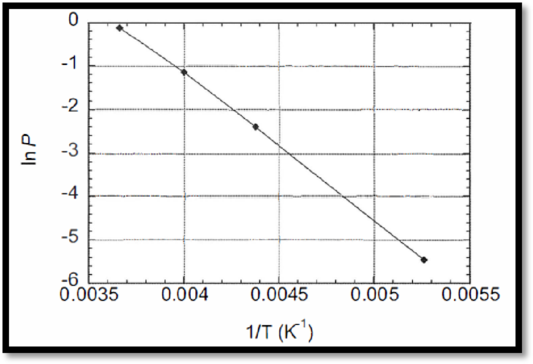
(a)
Interpretation:
The temperature dependence of the vapor pressure of phosphoryl chloride difluoride is given, ln p against 1/T has to be plotted.
Concept introduction:
The relationship to plot is In P versus 1/T is given below.
(a)
Explanation of Solution
Given,
| Temperature, T/K | 190 | 228 | 250 | 273 |
| Vapour pressure, P/Torr | 3.2 | 68 | 240 | 672 |
Unit conversion is given below,
Therefore,
| Temp. | V.P (Torr) | V.P (atm) | lnP | |
The ln p against 1/T plot is given below,

Figure 1
From the curve, slope is given below,
(b)
Interpretation:
The enthalpy of the vaporization has to be calculated.
Concept introduction:
Refer to part (a)
(b)
Explanation of Solution
The relationship to plot is In P versus 1/T, this gives a straight line.
From the curve, slope is given below,
The enthalpy of the vaporization is
(c)
Interpretation:
The entropy of the vaporization has to be calculated.
Concept introduction:
Refer to part (a)
(c)
Explanation of Solution
The relationship to plot is In P versus 1/T, this gives a straight line.
From the curve, slope is given below,
The entropy of the vaporization is
(d)
Interpretation:
The normal boiling point of phosphoryl chloride difluoride has to be calculated.
Concept introduction:
Refer to part (a)
(d)
Explanation of Solution
The normal boiling point of phosphoryl chloride difluoride is calculated when the vapor pressure is
Therefore, it will happen when.
The normal boiling point of phosphoryl chloride difluoride is
(e)
Interpretation:
If the pressure is 15 torr, temperature of phosphoryl chloride difluoride has to be calculated.
Concept introduction:
Refer to part (a)
(e)
Explanation of Solution
The temperature of phosphoryl chloride difluoride value is calculated as follows,
The temperature of phosphoryl chloride difluoride value is
Want to see more full solutions like this?
Chapter 5 Solutions
Chemical Principles: The Quest for Insight
- In what position will N-(4-methylphenyl)acetamide be nitrated and what will the compound be called.arrow_forwardDATA: Standard Concentration (caffeine) mg/L Absorbance Reading 10 0.322 20 0.697 40 1.535 60 2.520 80 3.100arrow_forwardIn what position will p-Toluidine be nitrated and what will the compound be called.arrow_forward
- In what position will 4-methylbenzonitrile be nitrated and what will the compound be called.arrow_forwardIn what position will benzenesulfonic acid be nitrated?arrow_forwardIf compound A reacts with an excess of methyl iodide and then heated with aqueous Ag₂O, indicate only the major products obtained. Draw their formulas. A Harrow_forward
- Explanation Check 1:01AM Done 110 Functional Groups Identifying and drawing hemiacetals and acetals In the drawing area below, create a hemiacetal with 1 ethoxy group, 1 propoxy group, and a total of 9 carbon atoms. Click and drag to start drawing a structure. ✓ $ 2025 McGraw Hill LLC. All Rights Reserved. Terms of Use Sarrow_forwardWrite the systematic name of each organic molecule: CI structure CI CI Explanation CI ठ CI Check B ☐ 188 F1 80 name F2 F3 F4 F5 F6 60 F7 2arrow_forwardWrite the systematic name of each organic molecule: structure i HO OH Explanation Check name ☐ ☐arrow_forward
- X 5 Check the box under each molecule that has a total of five ẞ hydrogens. If none of the molecules fit this description, check the box underneath the table. CI Br Br Br 0 None of these molecules have a total of five ẞ hydrogens. Explanation Check esc F1 F2 tab caps lock fn Q @2 A W # 3 OH O OH HO © 2025 McGraw Hill LLC. All Rights Reserved. Terms of Use | Privacy Center | Accessibility IK F7 F7 F8 TA F9 F10 & 6 28 * ( > 7 8 9 0 80 F3 O F4 KKO F5 F6 S 64 $ D % 25 R T Y U பட F G H O J K L Z X C V B N M H control option command P H F11 F12 + || { [ command optionarrow_forwardAn open vessel containing water stands in a laboratory measuring 5.0 m x 5.0 m x 3.0 m at 25 °C ; the vapor pressure (vp) of water at this temperature is 3.2 kPa. When the system has come to equilibrium, what mass of water will be found in the air if there is no ventilation? Repeat the calculation for open vessels containing benzene (vp = 13.1 kPa) and mercury (vp = 0.23 Pa)arrow_forwardEvery chemist knows to ‘add acid to water with constant stirring’ when diluting a concentrated acid in order to keep the solution from spewing boiling acid all over the place. Explain how this one fact is enough to prove that strong acids and water do not form ideal solutions.arrow_forward
 Chemistry: The Molecular ScienceChemistryISBN:9781285199047Author:John W. Moore, Conrad L. StanitskiPublisher:Cengage Learning
Chemistry: The Molecular ScienceChemistryISBN:9781285199047Author:John W. Moore, Conrad L. StanitskiPublisher:Cengage Learning Chemistry: An Atoms First ApproachChemistryISBN:9781305079243Author:Steven S. Zumdahl, Susan A. ZumdahlPublisher:Cengage Learning
Chemistry: An Atoms First ApproachChemistryISBN:9781305079243Author:Steven S. Zumdahl, Susan A. ZumdahlPublisher:Cengage Learning Chemistry: Principles and ReactionsChemistryISBN:9781305079373Author:William L. Masterton, Cecile N. HurleyPublisher:Cengage Learning
Chemistry: Principles and ReactionsChemistryISBN:9781305079373Author:William L. Masterton, Cecile N. HurleyPublisher:Cengage Learning Chemistry: Principles and PracticeChemistryISBN:9780534420123Author:Daniel L. Reger, Scott R. Goode, David W. Ball, Edward MercerPublisher:Cengage Learning
Chemistry: Principles and PracticeChemistryISBN:9780534420123Author:Daniel L. Reger, Scott R. Goode, David W. Ball, Edward MercerPublisher:Cengage Learning Chemistry & Chemical ReactivityChemistryISBN:9781337399074Author:John C. Kotz, Paul M. Treichel, John Townsend, David TreichelPublisher:Cengage Learning
Chemistry & Chemical ReactivityChemistryISBN:9781337399074Author:John C. Kotz, Paul M. Treichel, John Townsend, David TreichelPublisher:Cengage Learning Principles of Modern ChemistryChemistryISBN:9781305079113Author:David W. Oxtoby, H. Pat Gillis, Laurie J. ButlerPublisher:Cengage Learning
Principles of Modern ChemistryChemistryISBN:9781305079113Author:David W. Oxtoby, H. Pat Gillis, Laurie J. ButlerPublisher:Cengage Learning





